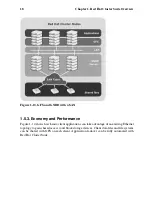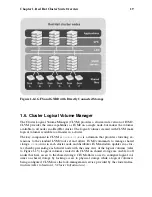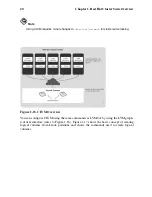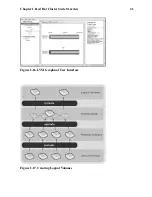
32
Chapter 1. Red Hat Cluster Suite Overview
The issue with ARP requests in a direct-routing LVS configuration is that because a client
request to an IP address must be associated with a MAC address for the request to be han-
dled, the virtual IP address of the LVS router must also be associated to a MAC. However,
because both the LVS router and the real servers have the same VIP, the ARP request is
broadcast to all the nodes associated with the VIP. This can cause several problems, such as
the VIP being associated directly to one of the real servers and processing requests directly,
bypassing the LVS router completely and defeating the purpose of the LVS configuration.
Using an LVS router with a powerful CPU that can respond quickly to client requests does
not necessarily remedy this issue. If the LVS router is under heavy load, it may respond
to the ARP request more slowly than an underutilized real server, which responds more
quickly and is assigned the VIP in the ARP cache of the requesting client.
To solve this issue, the incoming requests should
only
associate the VIP to the LVS router,
which will properly process the requests and send them to the real server pool. This can be
done by using the
arptables
packet-filtering tool.
1.8.4. Persistence and Firewall Marks
In certain situations, it may be desirable for a client to reconnect repeatedly to the same
real server, rather than have an LVS load-balancing algorithm send that request to the best
available server. Examples of such situations include multi-screen web forms, cookies,
SSL, and FTP connections. In those cases, a client may not work properly unless the trans-
actions are being handled by the same server to retain context. LVS provides two different
features to handle this:
persistence
and
firewall marks
.
1.8.4.1. Persistence
When enabled, persistence acts like a timer. When a client connects to a service, LVS
remembers the last connection for a specified period of time. If that same client IP address
connects again within that period, it is sent to the same server it connected to previously
— bypassing the load-balancing mechanisms. When a connection occurs outside the time
window, it is handled according to the scheduling rules in place.
Persistence also allows you to specify a subnet mask to apply to the client IP address test as
a tool for controlling what addresses have a higher level of persistence, thereby grouping
connections to that subnet.
Grouping connections destined for different ports can be important for protocols that use
more than one port to communicate, such as FTP. However, persistence is not the most effi-
cient way to deal with the problem of grouping together connections destined for different
ports. For these situations, it is best to use
firewall marks
.
Summary of Contents for CLUSTER SUITE - FOR RHEL 4
Page 1: ...Red Hat Cluster Suite for RHEL 4 Overview ...
Page 4: ......
Page 10: ...vi About This Document ...
Page 47: ...Chapter 1 Red Hat Cluster Suite Overview 37 Figure 1 25 Cluster Configuration Structure ...
Page 62: ...52 Chapter 1 Red Hat Cluster Suite Overview ...
Page 72: ...62 Chapter 2 Red Hat Cluster Suite Component Summary ...
















































